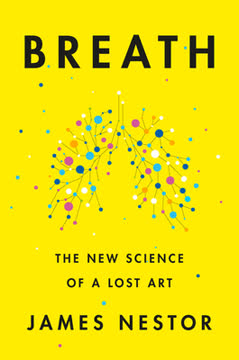Key Takeaways
1. Swimming is 70% technique, 30% fitness: Master efficiency first
"Fitness is something that happens to you while you're practicing good technique."
Efficiency trumps effort. In swimming, unlike many other sports, technique plays a far more significant role than raw fitness. The Total Immersion method emphasizes mastering efficient movements before focusing on building endurance or speed. This approach allows swimmers to cover greater distances with less effort and achieve faster times without necessarily working harder.
Technique-focused practice yields multiple benefits:
- Reduced energy expenditure
- Increased speed without additional effort
- Improved enjoyment of swimming
- Faster progress in skill development
By prioritizing technique, swimmers can break through plateaus and continue improving long after they would have stagnated with a traditional fitness-first approach. This principle applies to swimmers of all levels, from beginners to competitive athletes.
2. Balance and body position are fundamental to efficient swimming
"Press your buoy into the water and the water will press back."
Master balance first. Achieving proper balance in the water is the foundation of efficient swimming. The human body is not naturally designed to float horizontally, so swimmers must learn to distribute their weight effectively to maintain a streamlined position.
Key elements of balance in swimming:
- "Pressing the buoy": Using the lungs' buoyancy to lift the hips
- Keeping the head aligned with the spine
- Maintaining a horizontal body position
- Using the water's support to reduce effort
By mastering balance, swimmers can significantly reduce drag and energy expenditure. This allows them to focus on propulsion and speed rather than constantly fighting to stay afloat. Drills such as floating on the back and side-gliding help develop this crucial skill.
3. Streamlining and reducing drag dramatically improve speed
"Longer boats are faster. Longer bodies are too."
Reduce resistance to increase speed. Streamlining the body to reduce drag is one of the most effective ways to swim faster without expending more energy. By adopting a longer, more hydrodynamic shape in the water, swimmers can significantly improve their efficiency and speed.
Strategies for reducing drag:
- Extend the body to its full length during the stroke
- Rotate the body to reduce frontal surface area
- Enter the water cleanly with each stroke
- Maintain a neutral head position
Understanding and applying these principles can lead to dramatic improvements in swimming performance. Even small reductions in drag can translate to significant gains in speed and efficiency over longer distances.
4. Core-body rotation, not arm strength, powers efficient swimming
"If your body were a motorboat, your engine would be in your hips. Your hands are actually nothing more than the tips of the propeller blades."
Power from the core. Contrary to popular belief, efficient swimming relies more on core body rotation than arm strength. By rotating the body with each stroke, swimmers can generate power from larger muscle groups and reduce the strain on their shoulders and arms.
Benefits of core-driven swimming:
- Increased power and efficiency
- Reduced risk of shoulder injury
- Improved endurance
- More natural, fluid movements
Learning to initiate each stroke from the hips and core, rather than the arms, allows swimmers to maintain speed with less effort. This technique also helps prevent the common problem of "overreaching" with the arms, which can lead to inefficiency and injury.
5. Mindful practice of drills develops muscle memory for better technique
"Drills bypass all those vague translations. They simplify—and accelerate—the learning process. From the very beginning, you teach your body how it should feel when you swim well."
Practice with purpose. Mindful repetition of specific drills is key to developing proper swimming technique. These drills break down the complex movements of swimming into simpler, more manageable components, allowing swimmers to focus on individual aspects of their stroke.
Effective drill practice involves:
- Focusing on one skill or movement at a time
- Paying attention to sensations and feedback from the water
- Gradually increasing complexity as skills improve
- Alternating between drills and whole-stroke swimming
By practicing drills consistently and mindfully, swimmers can develop muscle memory for efficient movements. This approach leads to more natural, effortless swimming and allows for continuous improvement over time.
6. Breathing technique: Roll to breathe, don't lift your head
"Keep everything connected and aligned as you roll your head, neck, and torso as one unit to air."
Breathe with your body. Proper breathing technique is crucial for maintaining balance and efficiency in the water. Instead of lifting the head to breathe, which disrupts body position and increases drag, swimmers should learn to roll their entire body to the side.
Key aspects of efficient breathing:
- Rotating the body along its long axis
- Keeping one goggle in the water
- Exhaling continuously underwater
- Timing the breath with the natural rhythm of the stroke
By integrating breathing into the overall body rotation, swimmers can maintain their streamlined position and reduce energy expenditure. This technique also promotes a more relaxed, sustainable swimming style, especially over longer distances.
7. Interval training enhances both technique and fitness
"Total Immersion intervals are a little different from what you may be used to."
Smart intervals improve technique and fitness. Interval training in the Total Immersion method focuses on maintaining good technique while gradually building endurance and speed. This approach allows swimmers to develop their skills under various conditions and intensities.
Effective interval training strategies:
- Vary the length and intensity of intervals
- Focus on maintaining stroke efficiency during faster swims
- Use rest periods to assess and adjust technique
- Gradually increase the challenge as skills improve
By incorporating thoughtful interval training into their practice, swimmers can enhance both their technique and fitness simultaneously. This balanced approach leads to more sustainable improvements and reduces the risk of developing poor habits under fatigue.
8. Open water swimming requires specific preparation and strategies
"Swimming with no line to guide you, no bottom you can see, and no wall nearby for comfort? Buoys you have to find so you don't get lost, perhaps surf to fight, and who knows what else in the water out there besides swimmers?"
Prepare for the elements. Open water swimming presents unique challenges compared to pool swimming. Swimmers must adapt their techniques and develop new skills to navigate and perform effectively in natural bodies of water.
Key considerations for open water swimming:
- Sighting techniques to stay on course
- Adapting to waves and currents
- Managing temperature variations
- Drafting off other swimmers
- Safety precautions and equipment
Specific training for open water conditions, such as practicing sighting and swimming in groups, can greatly enhance performance and safety in these events. Swimmers should also focus on developing a relaxed, sustainable stroke that can be maintained over longer distances.
9. Injury prevention: Focus on shoulder health and functional strength
"Swimmer's shoulder" is common among swimmers because "human swimmers" instinctively try to muscle the water— rather than anchor the hand and let their core body do most of the work."
Protect your shoulders. The repetitive nature of swimming can lead to overuse injuries, particularly in the shoulders. By focusing on proper technique and complementary strength training, swimmers can reduce their risk of injury and improve their overall performance.
Strategies for injury prevention:
- Develop core strength to support efficient swimming
- Perform shoulder-specific exercises to improve stability
- Practice proper technique to reduce strain on joints
- Incorporate cross-training activities for balanced fitness
Regular attention to injury prevention and overall body conditioning can help swimmers maintain their health and continue improving over the long term. This holistic approach to swimming fitness contributes to both performance and longevity in the sport.
10. Masters swimming offers opportunities for all levels of swimmers
"Don't be put off by the word Masters. It doesn't mean what you may think."
Join the community. Masters swimming programs provide structured training and competition opportunities for adult swimmers of all abilities. These programs offer a supportive environment for improving technique, fitness, and enjoyment of swimming.
Benefits of Masters swimming:
- Access to coached workouts and technique instruction
- Opportunities for social interaction and motivation
- Structured competition for those interested
- A platform for lifelong fitness and skill development
Participating in a Masters program can greatly enhance a swimmer's progress and enjoyment of the sport. The inclusive nature of these programs makes them accessible to swimmers of all levels, from beginners to former competitive athletes.
Last updated:
FAQ
What's Total Immersion about?
- Revolutionary Approach: Total Immersion by Terry Laughlin introduces a new way to swim that focuses on efficiency and enjoyment rather than just strength and endurance.
- Fishlike Swimming Method: It teaches swimmers to emulate the natural movements of fish, emphasizing balance, streamlining, and fluidity.
- Mindful Practice: The book promotes a mindful approach to swimming, similar to yoga or tai chi, where mastering technique and enjoying the process are key.
Why should I read Total Immersion by Terry Laughlin?
- Improvement for All Levels: Whether you're a beginner or an experienced swimmer, the book offers insights to improve your swimming technique and enjoyment.
- Transformative Experience: Readers have reported significant improvements in swimming efficiency and comfort, making it a valuable resource for skill enhancement.
- Unique Perspective: It challenges traditional swim training methods, prioritizing technique over brute strength for a fresh perspective.
What are the key takeaways of Total Immersion?
- Technique Over Strength: The book emphasizes that 70% of swim speed comes from stroke mechanics, highlighting the importance of technique.
- Mindful Practice: It advocates for practicing swimming as a skill sport, where fitness naturally improves with good technique.
- Balance and Streamlining: Key concepts include achieving balance in the water and reducing drag by maintaining a streamlined body position.
What is the Total Immersion method?
- Fishlike Swimming: The method teaches swimmers to adopt a "Fishlike" approach, focusing on balance, streamlining, and fluid movements.
- Mindful Practice: It encourages practicing with intention, emphasizing understanding each movement rather than just going through the motions.
- Skill Drills: Incorporates specific drills to break down the swimming stroke into manageable parts for easier learning and mastery.
How does Total Immersion differ from traditional swim training?
- Technique First: Unlike traditional methods that prioritize endurance and strength, Total Immersion focuses on mastering technique as the foundation.
- Mind-Body Connection: Promotes a mindful approach, encouraging a deeper connection with movements and the water.
- Less Emphasis on Laps: Advocates for mastering flow and eliminating struggle before focusing on muscle power, suggesting fewer, more purposeful laps.
How does Total Immersion address the concept of drag?
- Understanding Drag: Explains that drag is the resistance swimmers face in the water, and reducing it is key to efficiency.
- Streamlined Position: Teaches techniques to achieve a streamlined position, minimizing drag for smoother movement.
- Practical Drills: Provides specific drills to help swimmers maintain a low-drag position, such as Skating and ZipperSwitch.
What are the benefits of mindful swimming as described in Total Immersion?
- Enhanced Focus: Encourages swimmers to concentrate on movements, leading to greater awareness and improved technique.
- Flow State Experience: Discusses achieving a "Flow State," where swimmers feel engaged and in control, enhancing enjoyment.
- Long-term Improvement: Mindful practice helps develop lasting habits that contribute to long-term success and satisfaction.
How can I apply the Total Immersion techniques to my swimming?
- Start with Drills: Begin by practicing specific skill drills to develop a strong foundation in balance and technique.
- Focus on Feel: Pay attention to how each movement feels, aiming to internalize the sensations of efficient swimming.
- Gradual Integration: As you become comfortable with the drills, integrate them into your full stroke, maintaining focus on technique.
What are some effective drills mentioned in Total Immersion?
- ZipperSkate Drill: Focuses on achieving balance and a streamlined position, helping to reduce drag.
- UnderSwitch Drill: Emphasizes body rotation and maintaining a low-drag position while breathing.
- Triple ZipperSwitch Drill: An advanced drill that integrates multiple skills, promoting fluid movement and efficiency.
How does Total Immersion suggest improving breathing technique?
- Bilateral Breathing Practice: Emphasizes practicing bilateral breathing for comfort and adaptability in various conditions.
- Drills for Breath Control: Recommends drills like ZipperSkate to learn breathing without disrupting stroke rhythm.
- Focus on Rolling to Air: Teaches rolling the body to breathe rather than lifting the head, maintaining a streamlined position.
What role does recovery play in the Total Immersion training approach?
- Essential for Improvement: Highlights that recovery is crucial for allowing the body to adapt and improve.
- Structured Rest Intervals: Recommends incorporating rest intervals into training to prevent fatigue and maintain technique quality.
- Mindful Recovery Practices: Encourages using recovery periods to reflect on technique and prepare mentally for the next set.
What are the best quotes from Total Immersion and what do they mean?
- “Fitness is something that happens to you while you’re practicing good technique.”: Emphasizes that focusing on technique naturally leads to improved fitness.
- “Practice makes permanent.”: Highlights the importance of consistently practicing the right techniques to avoid ingraining bad habits.
- “Swim as well as you drill.”: Encourages maintaining the same level of technique in whole-stroke swimming as in drills for consistent improvement.
Review Summary
Total Immersion receives mostly positive reviews for its effective swimming technique, focusing on efficiency and mindfulness. Readers appreciate the detailed drills and explanations, though some find the book repetitive and lacking visuals. Many report significant improvements in their swimming, from beginners to experienced swimmers. The method is praised for its focus on technique over fitness. Some criticize the book's verbosity and marketing-heavy content. Overall, readers find the Total Immersion approach revolutionary, though the book itself could be more concise and better illustrated.
Similar Books










Download PDF
Download EPUB
.epub digital book format is ideal for reading ebooks on phones, tablets, and e-readers.




